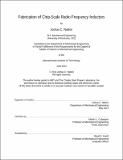| dc.contributor.advisor | Martin L. Culpepper. | en_US |
| dc.contributor.author | Nation, Joshua C. (Joshua Caleb) | en_US |
| dc.contributor.other | Massachusetts Institute of Technology. Department of Mechanical Engineering. | en_US |
| dc.date.accessioned | 2014-12-08T18:09:36Z | |
| dc.date.available | 2014-12-08T18:09:36Z | |
| dc.date.copyright | 2014 | en_US |
| dc.date.issued | 2014 | en_US |
| dc.identifier.uri | http://hdl.handle.net/1721.1/92067 | |
| dc.description | Thesis: S.M., Massachusetts Institute of Technology, Department of Mechanical Engineering, 2014. | en_US |
| dc.description | This electronic version was submitted by the student author. The certified thesis is available in the Institute Archives and Special Collections. | en_US |
| dc.description | Cataloged from student-submitted PDF version of thesis. | en_US |
| dc.description | Includes bibliographical references (pages 101-104). | en_US |
| dc.description.abstract | The purpose of this research was to learn the relationship between force and deformation in forming of micro-scale inductor coils. This was accomplished by applying large-deflection beam bending to the case of planar wire deformation and through experimental validation. Generating this knowledge is important because it establishes fabrication limits for wire-based chip-scale inductors. There are many potentially viable methods for fabricating planar inductor coils. Without an understanding of the relevant physics, it is impossible to know which of these techniques is most appropriate or even feasible. The analysis presented in this thesis directly led to the stencil-and-guide inductor fabrication concept, the details of which were specified using an analytic electrical model. The process utilizes a wire conductor, is compatible with any desired substrate, and features the ability to exactly control spiral properties. Multiple inductors were fabricated using this process. These inductors demonstrate performance specifications predicted by the model, including inductances ranging from 2 - 4 nH, quality factors in excess of 100, and self-resonant frequencies beyond 10 GHz. Furthermore, the area of the inductors is less than 1.5 mm2 and the entire device thickness is only 260 [mu]m. The inductors are most readily applied to increasingly small communication devices, which require thin and efficient electrical components to boost the performance of the radio frequency transceiver. Accordingly, these inductors offer the potential for substantial improvement in signal quality and reception. | en_US |
| dc.description.statementofresponsibility | by Joshua C. Nation. | en_US |
| dc.format.extent | 104 pages | en_US |
| dc.language.iso | eng | en_US |
| dc.publisher | Massachusetts Institute of Technology | en_US |
| dc.rights | M.I.T. theses are protected by copyright. They may be viewed from this source for any purpose, but reproduction or distribution in any format is prohibited without written permission. See provided URL for inquiries about permission. | en_US |
| dc.rights.uri | http://dspace.mit.edu/handle/1721.1/7582 | en_US |
| dc.subject | Mechanical Engineering. | en_US |
| dc.title | Fabrication of chip-scale radio frequency inductors | en_US |
| dc.type | Thesis | en_US |
| dc.description.degree | S.M. | en_US |
| dc.contributor.department | Massachusetts Institute of Technology. Department of Mechanical Engineering | |
| dc.identifier.oclc | 897206098 | en_US |
